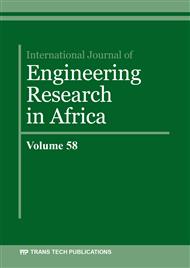[1]
A. Ampaiboon, O.U Lasunon, B. Bubphachot, Optimization and prediction of ultimate tensile strength in metal active gas welding, Scientific world journal, Hindawi publishing corporation, Article ID 831912, (2015), 1-5.
DOI: 10.1155/2015/831912
Google Scholar
[2]
M.M. Khan, L. Romoli, M. Fiaschi, G. Dini, F. Sarri, Multi response optimization of laser welding of stainless steels in a constrained fillet joint configuration using RSM, International journal of advanced manufacturing technology, 62, (2012), 587-603.
DOI: 10.1007/s00170-011-3835-z
Google Scholar
[3]
S.D. Gite, H.V. Shete, Analysis and optimization of T-joint argon gas welding process parameters for stainless steel AISI 310: A review, International journal of scientific research in engineering and management, 3, (2019), 1-8.
DOI: 10.4028/www.scientific.net/jera.58.1
Google Scholar
[4]
S. A. Rizvi, Application of Taguchi technique to optimize the GMA welding parameters and study of fracture mode characterization of AISI 304H welded joints, International review in applied science and engineering, 9, (2018), 9–16.
DOI: 10.1556/1848.2018.9.1.2
Google Scholar
[5]
Dr. S.V. Anil Kumar, Dr. R. Gandhinathan, Process parameters for metal inert gas welding of mild steel by using Taguchi technique – A review, International journal of material sciences and technology, Research india publications, 10, (2020), 1-14.
Google Scholar
[6]
Er. Saurabh, V.S Aher, V.D. Wakchaure, Parametric optimization of MIG welding process to improve its tensile strength, EPRA international journal of research and development, 4, (2019), 75-82.
Google Scholar
[7]
R. Dasharath, Modelling and optimization of electron beam welding process using ANOVA, International symposium of research students on material science and engineering, 20, (2004), 1-11.
Google Scholar
[8]
K.Y. Benyounis, A.G. Olabi, M.S.J. Hashmi, Multi-response optimization of CO2 laser-welding process of austenitic stainless steel, Optics & laser technology, 40, (2008), 76–87.
DOI: 10.1016/j.optlastec.2007.03.009
Google Scholar
[9]
H.N. Moosavy, M. Shamanian, F. Ashrafizadeh, Micro structural evolutions in dissimilar welds between AISI 310 austenitic stainless steel and Inconel 657, Journal of materials science, 45, 2564– 2573.
DOI: 10.1007/s10853-010-4227-8
Google Scholar
[10]
S. Kršćanski, G. Turkalj, FEM stress concentration factors for fillet welded CHS-plate T-joint, Engineering review, 32, (2012), 147-155.
Google Scholar
[11]
Y.H. Manurung, R. Ngendang, A.K. Lidam, Welding distortion analysis of multi pass joint combination with different sequences using 3D FEM and experiment, International journal of pressure vessels and piping, 5, (2013), 1-10.
DOI: 10.1016/j.ijpvp.2013.05.002
Google Scholar
[12]
P.K. Pillani, M. Saju, Modelling and optimization of process parameters for TIG welding of aluminium 65032 using response surface methodology, International journal of engineering and research application, 3, (2013), 230-236.
Google Scholar
[13]
R. Kassab, H. Champliaud, J. Lanteigne, Finite element modeling of a welded T-joint, Proceedings of the Canadian society for mechanical engineering forum 2010, CSME forum, (2010), 1-5.
Google Scholar
[14]
E.A. Al-Bahkali, M.H. Es-saheb, J. Herwan, Stresses distribution in spot, bonded, and weld-bonded joints during the process of axial load, World academy of science, engineering and technology, 6, (2012), 1195-1200.
DOI: 10.19026/rjaset.7.885
Google Scholar
[15]
I.A. Ibrahim, S.A. Mohamat, A. Amir, A. Ghalib, The effect of gas metal arc welding process on different welding parameters, International symposium on robotics and intelligent sensors, 41, (2012), 1502-1506.
DOI: 10.1016/j.proeng.2012.07.342
Google Scholar
[16]
H.V. Shete, M.S. Sohani, Effect of process parameters on surface roughness in HPC drilling of AISI 1055 steel, Journal of mechanical engineering - Universiti teknologi MARA, 17, (2020), 33-48.
DOI: 10.24191/jmeche.v17i1.15217
Google Scholar
[17]
H.V. Shete, M.S. Sohani, Effect of process parameters on hole diameter accuracy in high pressure through coolant peck drilling using Taguchi technique, International journal of material forming and machining processes, IGI global publication, 5, (2018), 12-31.
DOI: 10.4018/ijmfmp.2018010102
Google Scholar
[18]
Minitab, Minitab release 19-Stat guide, Minitab, (2019).
Google Scholar
[19]
J.E.R. Dhas, K. Somasundaram, Modeling and prediction of HAZ using finite element and neural network modeling, Advances in production engineering & management, 8, (2013), 13–24.
DOI: 10.14743/apem2013.1.149
Google Scholar
[20]
P. Paulraj, R. Garg, Effect of welding parameters on mechanical properties of GTAW of UNS S31803 and UNS S32750 weldments, Manufacturing review, 2, (2015), 1-9.
DOI: 10.1051/mfreview/2015032
Google Scholar
[21]
M. Yang, J. Lu, Y. Li , J. Tan , W. Zhang , H. Yang, Effects of the wire feeding speed on the mechanical properties and electrochemical corrosion behaviors of a hybrid laser MAG welded X90 pipeline steel, International journal of electrochemical science, 15, (2020), 9811–9823.
DOI: 10.20964/2020.10.61
Google Scholar
[22]
K.M. Hafez, M.M. Ghanem, H.A. Abdel-Aleem, N. Fathy, Effect of welding processes on mechanical and microstructural characteristics of DP780 steel welded joints for the automotive industry, Key engineering materials, 835, (2020), 101-107.
DOI: 10.4028/www.scientific.net/kem.835.101
Google Scholar
[23]
M.S. Chandra, P.P. Kumar, B.Asish, R. Ramesh, Determination of tungsten inert gas welding input parameters to attain maximum tensile strength of 316L austenitic stainless steel , Journal of mechanical engineering, 68, (2018), 231–248.
DOI: 10.2478/scjme-2018-0037
Google Scholar


